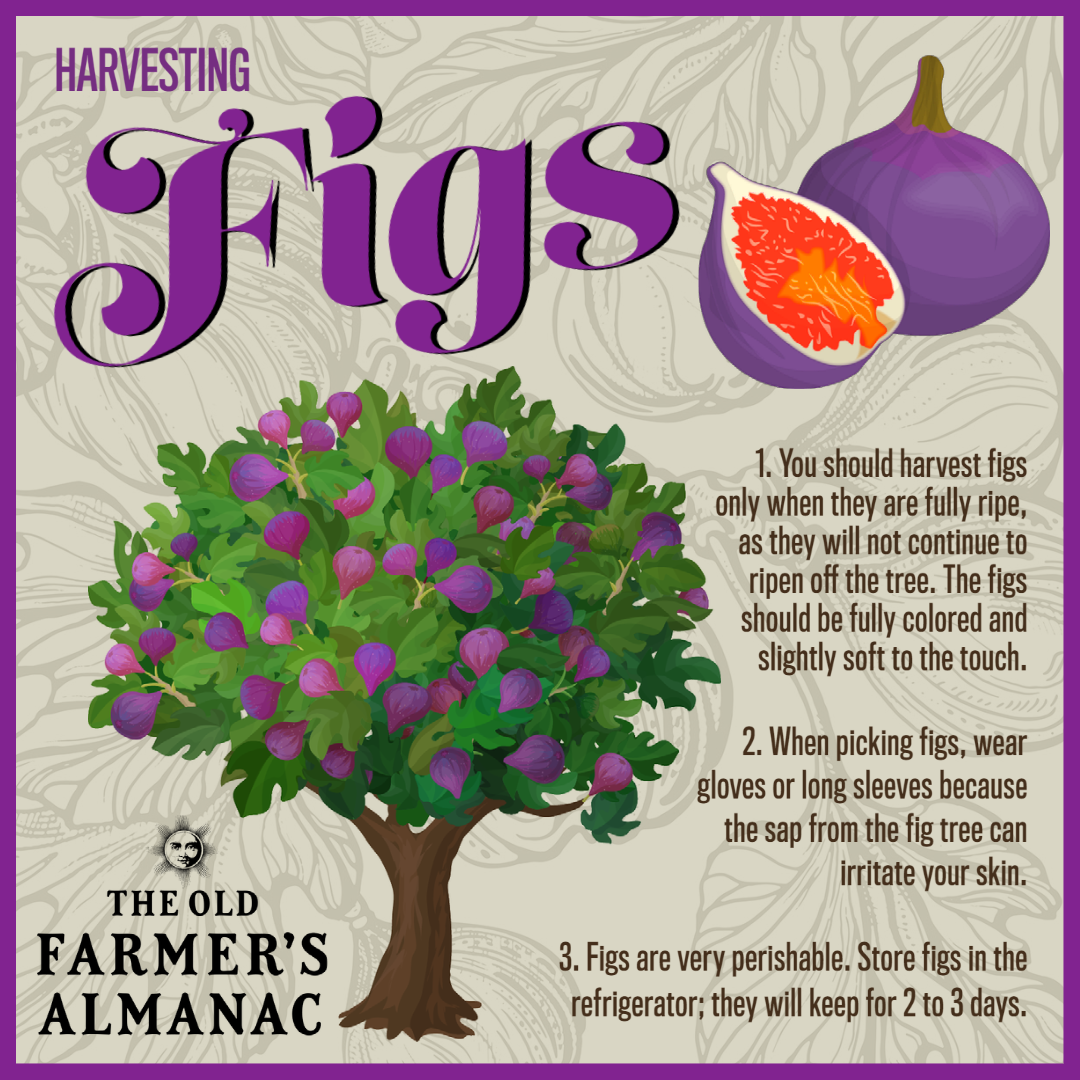
Grow your own fig tree—even in cooler climates!
Types
- ‘Brown Turkey’ produces abundant medium to large figs. This type works best in warm climates but is fairly tolerant of cooler temperatures, too.
- ‘Celeste’ produces small, sweet, purplish figs. It is one of the more winter-hardy varieties.
- ‘Hardy Chicago’ is a winter-hardy variety that produces purple, medium-size figs.
- ‘King’ is well adapted for the cooler conditions found in the Northwest. It produces medium figs that are sweet and rich in flavor.
- ‘Kadota’ vigorously produces small to medium fruit. Its figs are rich and sweet, and it is the most commonly canned fig.
Figs are fairly unique trees, so they should be easy to identify if you know what to look for! First look at the leaf: it should be quite large and have three to five lobes. Then look at the fruit: the color of the ripe fruit depends on the variety, but they may range from lime green to brown to purple. The stems of the fig fruit are fairly thick (not thin, like an apple or pear’s stem). Search in Google for images of fig leaves and see how yours compare. Finally, if you want to be absolutely sure, contact your local state Cooperative Extension Service, which should be able to ID the tree with a photo.
I live in D/FW area and have a brown turkey fig tree. Ants invade the fruit at the blossom end. Lately it has stopped, but I think that's because of a little lizard/gecko type thing. If the ants return, any suggestions on how to remedy the situation?
Hi Heather,
If the ants return, try sprinkling diatomaceous earth or broken eggshells around the base of the tree. It’s a simple solution and should cut up the ants as they pass through to climb the tree. We hope this helps!
Hello! Thanks for the great site and article. My family brought a fig tree over from Italy back in the 1920s. That tree has been moved from house to house until ending up at my mother's house in NJ. She sold her house about a year and a half ago, and we were unable to take the tree with us unfortunately. However, I tried to propagate the tree with multiple fig cuttings. Most failed, but one has survived and is still going. However, the main trunk/stem of the cutting seems to have died a while ago and is not really growing. The surviving part of the main stem comes out about two inches from the dirt and is healthy, and there is one branch growing off that section. This sole branch is growing well, and is probably about two and a half feet long, currently sprouting new growth. It is in a 12 inch diameter pot. My question - is there hope for this tree to grow more than just this one branch? Also, should I do anything with it (bigger pot, plant outside, etc.) I'm afraid to move it outside permanently in case it doesn't work.
Thanks in advance!
We can always have hope, Michael, but sometimes a backup plan is needed, too. It’s impossible to know if the tree will grow another branch or if this branch will survive…but it does not sound promising—and I share that from experience. You might consider purchasing a new plant, one of some size, and continue the family legacy that way, nearly a century later.
We’ve had a fig tree for three years. Iit’s doing fine except the leaves are yellowish. How do we remedy this?
I was just wondering if you could graft a branch onto a different rootstock and maybe save it that way?
Hi, don't give up on your fig twig just yet. I live in the Canary Islands and had the same problem.. just a single twig that would not seem to grow at all. Then, one day, I bumped into an old lady who had lived on the islands all her life and has the most beautiful garden filled with big healthy trees. She told me that it took 7 years for an old stem to settle ... she actually said ( in Canarian Spanish ) "That the fig needs to decide if it wants to live with you and wants to share its fruits with you". She was right.. almost to the day.. in the 7th spring of me owning the twig.. it started to grow and is now a huge, healthy tree that bears more fruit than we know what to do with. Maybe there is something in old wives tales after all!
You could take the one branch as a cutting and start fresh, or you could if possible return to the original tree location ask new owners for clippings explaining the heritage of the tree and your family, Im sure they would allow it and also have a bit of knowledge themselves of their fig tree
A friend gave me a fig tree cutting from her Kadota tree for me to plant. It has done well, but the central branch of the cutting died early and two off shoots have grown fantastically. I will soon transplant it to my backyard as it will grow much bigger than the 5-gallon pot it is in, but I worry that the branches only form a V-shape and have no central trunk (except for 2 inches worth that the V is attached to).
Will this cause me problems later? I worry if the branches grow out and get bigger, their weight will eventually break them off. Is there a way to help this? I want to keep this tree as I love figs and it is very healthy otherwise.










